|
|
 |
|
Calanoida ( Order ) |
|
|
|
Clausocalanoidea ( Superfamily ) |
|
|
|
Clausocalanidae ( Family ) |
|
|
|
Ctenocalanus ( Genus ) |
|
|
| |
Ctenocalanus citer Heron & Bowman, 1971 | |
| | | | | | | Syn.: | Ctenocalanus vanus : ? Giesbrecht, 1902 (p.19); ? Farran, 1929 (part., p.208, 226); ? Hardy & Gunther, 1935 (1936) (p.149, Rem.); ? Vervoort, 1951 (p.59); ? 1957 (p.37); ? Tanaka, 1960 (p.35); ? Senô & al., 1963 a (p.4, 5); 1966 (p.4, 5); Ramirez, 1966 (p.12, figs.M); ? Arcos, 1976 (p.85, Rem.: p.91, Table II, fig.9); ? Fukuchi & Tanimura, 1981 (p.37); ? Hoshiai & Tanimura, 1981 (p.44); ? Zmijewska, 1987 (tab.2a); Kawaguchi & al., 1986 (tab.2)
Ctenocalanus sp. : Kellermann, 1990 (p.159, Table 1, predation) [probably this species] | | | | Ref.: | | | Heron & Bowman, 1971 (p.142, figs.F,M, juv.); Björnberg & al., 1981 (p.629, figs.F,M); Prado Por, 1986 (p.517); Razouls, 1994 (p.48, figs.F,M); Bradford-Grieve, 1994 (p.127, figs.F,M, Rem.); Mazzocchi & al., 1995 (p.161, figs.F,M, Rem.); Menshenina & Melnikov, 1995 (p.128); Bradford-Grieve & al., 1999 (p.878, 917, figs.F,M); Suarez-Morales & Leon-Oropeza, 2000 (p.39, tab.1, Rem.); Bucklin & al., 2003 (p.335, tab.2, Biomol); Michels & Schnack-Schiel, 2005 (p.483, fig.3: Md); Vives & Shmeleva, 2007 (p.629, figs.F,M, Rem.); Cheng F. & al., 2013 (p.119, molecular biology, GenBank) | 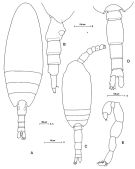 Issued from: M.G. Mazzocchi, G. Zagami, A. Ianora, L. Guglielmo & J. Hure in Atlas of Marine Zooplankton Straits of Magellan. Copepods. L. Guglielmo & A. Ianora (Eds.), 1995. [p.162, Fig.3.28.1]. Female: A, habitus (dorsal); B, urosome (lateral right side). Proportional lengths of urosomites and furca 34:18:14:16:18 = 100 Male: C, habitus (dorsal); D, urosome (dorsal); E, P5. Proportional lengths of urosomites and furca 12:32:18:14:10:14 = 100.
|
 Issued from: M.G. Mazzocchi, G. Zagami, A. Ianora, L. Guglielmo & J. Hure in Atlas of Marine Zooplankton Straits of Magellan. Copepods. L. Guglielmo & A. Ianora (Eds.), 1995. [p.163, Fig.3.28.2]. Female (SEM preparation): D, Exopodal saegments 1-3 of P4; E, , F, detail of outer spines of P4, with comb-like ridges on medial margin (arrows in D). Bars: D, E 0.010 mm; F 0.005 mm.
|
 issued from : E. Suarez M. & A. Leon-Oropeza in Gulf and Caribbean Research, 2000, 12. [p.39, Table I]. Characters used to separate the known species of Ctenocalanus. c/u ratio = cephalosome/urosome length ratio.
|
 issued from : J. Michels & S.B. Schnack-Schiel in Mar. Biol., 2005, 146. [p.486, Fig.3]. Mandibular gnathobase. a: Female (from Weddell and Bellingshausen Seas); b, Male a, b: left gnathobase from cranial; V: ventral tooth, C1-C4: central teeth, D1-D3: dorsal teeth, B: dorsal bristle, T: tooth-like structure, arrow: the male gnathobase.. Scale bars 0.020 mm. Nota: The gnathobase morphology with its strong and relatively short and edgeless teeth suggests phytoplankton as the main food source. Since, the to date investigated specimens have only had phytoplankton, mainly pennate diatoms, in their guts (Hopkins & Torres, 1989; Schnack-Schiel & Misdalski, 1994) and C. citer was the copepod species with the largest abundance in zooplankton samples that were taken directly under the sea ice (Fukuchi & Tanimura, 1981; Tanimura & al., 1984), one can assume that this species feeds predominantly on phytoplankton.
|
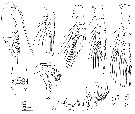 issued from : Heron G.A. & Bowman T.E. in Biology of the Antarctic Seas IV. Antarct. Res. Ser. Washington, 1971, 17. [p.162, Figs.130-139]. Female (from Antarctic area): 130, habitus (lateral); 131, genital field (ventral; 132, right A2; 133, right Mxp; 134, P1; 135, P2; 136, P3; 137, P4; 138, P5; 139, P5 (another specimen).
|
 issued from : Heron G.A. & Bowman T.E. in Biology of the Antarctic Seas IV. Antarct. Res. Ser. Washington, 1971, 17. [p.142, Fig.1]. Female: outer spine of exopod 2 and proximal spines of exopod 3 of P4.
|
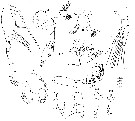 issue from : Heron G.A. & Bowman T.E. in Biology of the Antarctic Seas IV. Antarct. Res. Ser. Washington, 1971, 17. [p.162, Figs.140-150]. Male: 140, habitus (lateral); 141, left A2; 142, right Md; 143, right Mx1; 144, left Mx2; 145, right Mxp; 146, P1; 147, P2 (protopod); 148, P3 (protopod); 149, P5; 150
P5 (another specimen).
|
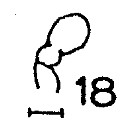 Issued from : J.M. Bradford in N.Z. Oceanogr. Inst., 1971, 206, Part 8, No 59. [p.17, Fig.18]. As Ctenocalanus vanus. Female (from Ross Sea): 18, P5. Scale bar: 10 µm.
|
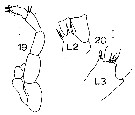 Issued from : J.M. Bradford in N.Z. Oceanogr. Inst., 1971, 206, Part 8, No 59. [p.17, Figs.19, 20]. As Ctenocalanus vanus. Male (from Ross Sea):19, P5; 20, basis of P2 and P3 (L2 and L3 respectively ). Scale bar: 10 µm.
|
 Issued from : J.M. Bradford in N.Z. Oceanogr. Inst., 1971, 206, Part 8, No 59. [p.15, Figs.15, 16]. As Ctenocalanus vanus. Male (from Ross Sea): 15, A1; 16, P1. Scale bar: 100 µm.
|
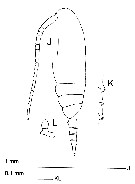 issued from : J.M. Bradford-Grieve in The Marine Fauna of New Zealand: Pelagic Calanoid Copepoda. National Institute of Water and Atmospheric Research (NIWA). New Zealand Oceanographic Institute Memoir, 102, 1994. [p.126, Fig.73, J-L]. Female (from 61°25.5'S, 170°41'E): J, habitus (lateral); K, outer-edge spines of exopodal segments 2 and 3 of P4; L, P5.
|
 issued from : J.M. Bradford-Grieve in The Marine Fauna of New Zealand: Pelagic Calanoid Copepoda. National Institute of Water and Atmospheric Research (NIWA). New Zealand Oceanographic Institute Memoir, 102, 1994. [p.126, Fig.73, M-O]. Male (from 42°24.5'S, 174°01.8'E): M, basipod 2 (= basis) of P2; N, basipod 2 (= basis) of P3; O, P5.
|
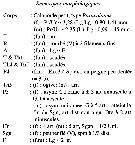 Issued from : C. Razouls in Ann. Inst. océanogr., Paris, 1994, 70 (1). [p.48]. Caractéristiques morphologiques de Ctenocalanus citer femelle et mâle adultes. Terminologie et abbréviations: voir à Calanus propinquus. Nota: peut être confondu avec vtenocalanus vanus, cette dernière àvec A1 > F de plusieurs segments. Exopodite 3 de P4 ç épine externe en peigne plus denté (= 6-8 dents). Mâle à P5 droite généralement absente. Les stades copépodites 1 à 5 sont décrits par Heron & Bowman (1971, p.145-157).
| | | | | Compl. Ref.: | | | Schnack & al., 1985 (p.256, fig.4); Hopkins, 1985 (p.197, Table 1, gut contents); Hopkins & Torres, 1988 (tab.1); Tucker & Burton, 1990 (p.591, tab.1, fig.4, seasonal, spatia lveriations); Freire & al., 1993 (tab.3); Schnack-Schiel & Mizdalski, 1994 (p.357, seasonal variations); Knox & al., 1996 (tab.1); Errhif & al., 1997 (p.422); Fransz & Gonzalez, 1997 (p.395, biomass v.s. N-S transect); Elwers & Dahms, 1998 (p.150, 151, fig.1, 2, seasonal abundance); Mauchline, 1998 (tab.47, 58); Atkinson, 1998 (p.289, 291, Table 1: biological data); Voronina & Kolosova, 1999 (p.71); Razouls & al., 2000 (p.343, tab. 3, 5, Appendix); Zmijewska & al., 2000 (p.89); Hunt & al., 2001 (p.374, tab.1); Chiba & al., 2001 (p.95, tab.4, 7); Uysal & al., 2002 (p.17, tab.1, Rem.: p.19); Dubischar & al., 2002 (p.3871, abundance, Rem.: p.3877, 3881); Cabal & al., 2002 (p.869, Table 1, abundance); Labat & al., 2002 (p.741, tab.3); Marrari & al., 2004 (p.667, tab.1); Hunt, 2004 (p.1, 43, 47, 74, Table 3.2, 4.4, fig.4.7, 4.11, Rem.: p.97, fig.5.10: seasonal abundance); Fuentes & Schnack-Schiel, 2005 (p.253); Hunt & Hosie, 2006 (p.1182, seasonal succession, indicator); 2006 a (p.1203, tab.2,fig.8); Dias & Araujo, 2006 (p.43, Rem., chart); Tsujimoto & al., 2006 (p.140, Table1); Deibel & Daly, 2007 (p.271, Table 6a, Rem.: Antarctic polynyas); Pasternak & Schnack-Schiel, 2007 (p.493, feeding); Guglielmo & al., 2007 (p.747, Table 5); Biancalana & al., 2007 (p.83, Tab.2, 3); Schnack-Schiel & al., 2008 (p.1045: Tab.2); Schnack-Schiel & al., 2008 (p.1056, Table 1, 4); Muelbert & al., 2008 (p.1662, Table 1, 3); Kiko & al., 2008 (p.1000, Table 3); Park & Ferrari, 2009 (p.143, Table 2, Appendix 1, biogeography from Southern Ocean); Takahashi & al., 2010 (p.317, Table 3, 4, figs.4, 5, 6, 7, 8); Hidalgo & al., 2010 (p.2089, Table 2); Swadling & al., 2010 (p.887, Table 2, 3, A1, fig.6, abundance, indicator species); Dias & al., 2010 (p.230, Table 1); Yang & al., 2011 a (p.921, Table 2, inter-annual variation 1999-2006); Guglielmo & al., 2012 (p.1301,Table 3); Ward & al., 2012 (p.78, Table B1, abundance, weight); Uysal & Shmeleva, 2012 (p.909, Table I, Rem.: p.928, 929); Thompson G.A. & al., 2012 (p.127, Table 2, 3, fig.5); Thompson G. & al., 2012 (p.367, Rem.: p.378); Makabe & al., 2012 (p.432, Table II, abundance vs mesh-size used); Michels & al., 2012 (p.369, Table 1, occurrence frequency, vertical distribution); Aguirre & al., 2012 (p.341, Table I: abundance vs season, figs.4, 6, 7); Yang G. & al., 2013 (p.1701, fig.4, Table 2, feeding); Ojima & al., 2013 (p.1293, Table 2, 3, fig.3, abundance); Bonecker & a., 2014 (p.445, Table II: frequency, horizontal & vertical distributions); Dias & al., 2015 (p.483, Table 2, abundance, biomass, production, Table 4: % vs. season); Dias & al., 2018 (p.1, Table 2: vertical distribution, abundance vs. season); Dias & al., 2018 a (p.189, Rem.: p.196); Acha & al., 2020 (p.p.1, Table 3: occurrence % vs ecoregions). | | | | NZ: | 6 | | |
|
Distribution map of Ctenocalanus citer by geographical zones
|
| | | | | | | | | 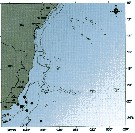 issued from : C. de O. Dias & A.V. Araujo in Atlas Zoopl. reg. central da Zona Econ. exclus. brasileira, S.L. Costa Bonecker (Edit), 2006, Série Livros 21. [p.43]. issued from : C. de O. Dias & A.V. Araujo in Atlas Zoopl. reg. central da Zona Econ. exclus. brasileira, S.L. Costa Bonecker (Edit), 2006, Série Livros 21. [p.43].
Chart of occurrence in Brazilian waters (sampling between 22°-23° S).
Nota: 48 specimens . |
 Issued from : S.B. Schnack-Schiel & E. Mizdalski in Mar. Biol., 1994, 119. [p.364, Fig.6]. Issued from : S.B. Schnack-Schiel & E. Mizdalski in Mar. Biol., 1994, 119. [p.364, Fig.6].
Ctenocalanus citer from East Weddell Sea. Cumulative percentage of females in different stages of maturity.
Number below bars: absolute numbers of females inspected.
Late winter/early spring: in 1986; Summer: in 1985; Autumn: in 1992. |
 Issued from : J. Michels, S.B. Schnack-Schiel, A. Pasternak, E. Mizdalski, E. Isla & D. Gerdes in Polar Biol., 2012, 35. [p.379, Fig.10 (part., copepodid stages omitted.)]. Issued from : J. Michels, S.B. Schnack-Schiel, A. Pasternak, E. Mizdalski, E. Isla & D. Gerdes in Polar Biol., 2012, 35. [p.379, Fig.10 (part., copepodid stages omitted.)].
Vertical distribution of the adult females and males of Ctenocalanus citer from East Weddell Sea shelf (70°48.558'S, 10°43.698'W) between 9 and 28 December 2003. The water depth at the sampling spots varied between 438 and 484 m.
The white dots represent the weighted mean depths. |
 Issued from : C. de O. Dias, A. V. de Araujo & S.L.C. Bonecker in Zoologia, 2018, 35. [p.5, Table 2]. Issued from : C. de O. Dias, A. V. de Araujo & S.L.C. Bonecker in Zoologia, 2018, 35. [p.5, Table 2].
Vertical distribution of the mean (S.D.) density (ind. m3) of the two congeners Ctenocalanus citer and Ctenocalanus vanus in The Campos Basin (23°55'- 22°N, 41°44'-38°41'W) during the rainy (RS) and dry (DS) seasons, from the continental shelf (0-130 m) to the depth line 3000 m.
Mesozooplankton samples collected by horizontal hauls with MultiNet type (200 µm mesh aperture).
Rainy season: February-April and dry season: August- September 2009.
The sampling stations distributed along 6 transects perpendicular to the coast in a north-south ditrection. |
 Issued from : K.M. Swadling, So. Kawaguchi & G.W. Hosie in Deep-Sea Research II, 2010, 57. [p.897, Fig.6 (continued)]. Issued from : K.M. Swadling, So. Kawaguchi & G.W. Hosie in Deep-Sea Research II, 2010, 57. [p.897, Fig.6 (continued)].
Distribution of indicator species Ctnenocalanus citer from the BROKE-West survey (southwest Indian Ocean) during January-February 2006.
Sampling with a RMT1 net (mesh aperture: 315 µm), oblque tow from the surface to 200 m.
The survey area was located predominantly within the seasonal ice zone, and in the month prior to the survey there was considerable ice coverage over the western section but none over the east.
See map showing sampling sites in Calanus propinquus. |
| | | | Loc: | | | Antarct. (King George Is., Potter Cove, ? S & SE Peter Ist Island, Croker Passage, Peninsula, Drake Passage, Scotia Sea, ? South Georgia, Syowa Station, Weddell Sea, Indian, Lützow-Holm Bay, McMurdo Sound, Station Davis, Ross Sea, Prydz Bay), Beagle Channel, Strait of Magellan, sub-Antarct. (off W Prince Edward , Indian, SE Pacif., S Indian (subtropical convergence) , New Zeland (SE North Island), Ushuaia, Chile (N-S), off Mar del Plata, Uruguay (continental shelf), S Brazil (off Macaé, off Rio de Janediro, Guanabara Bay, Campos Basin, off Vitoria-Cabo de Sao Tomé), E Mediterranean Sea (N Lebanon Basin) | | | | N: | 68 ? | | | | Lg.: | | | ?(33) F: 1-1,3; (36) F: 1,45-1,06; M: 1,45-1,1; (371) F: 1,41-0,8; M: 1,45-0,99; {F: 0,80-1,45; M: 0,99-1,45}
The mean female size is 1.180 mm (n = 4; SD = 0.3080), and the mean male size is 1.248 mm (n = 4; SD = 0.2381). The size ratio (male : female) is 1.082. | | | | Rem.: |
Sampling depth (Antarct., sub-Antarct.) : 0-1000 m.
Certain identifications, before and after 1971, under the designation of Ctenocalanus vanus correspond without doubt to C. citer in Antarctica. This essentially Antarctic species can be observed up till 40° S.
Uysal & al. (2002) indicate this species for the first time in the Mediterranean Sea.
Mazzocchi & al (1995) emphasize: A1 reaches the posterior margin of the caudal rami (in C. vanus, A1 exceeds the caudal rami by several segments) and for the male with a 1-segmented right P5 (C. vanus without right P5).
See remarks in Ctenocalanus heronae. | | | Last update : 17/06/2021 | |
|
|
 Any use of this site for a publication will be mentioned with the following reference : Any use of this site for a publication will be mentioned with the following reference :
Razouls C., Desreumaux N., Kouwenberg J. and de Bovée F., 2005-2025. - Biodiversity of Marine Planktonic Copepods (morphology, geographical distribution and biological data). Sorbonne University, CNRS. Available at http://copepodes.obs-banyuls.fr/en [Accessed November 30, 2025] © copyright 2005-2025 Sorbonne University, CNRS
|
|
 |
 |


















